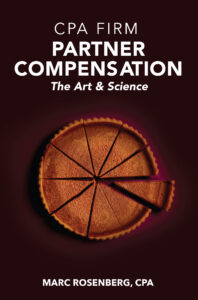What’s It Like Changing to a Compensation Committee?
![]() Marc Rosenberg, CPA / Sep 8, 2021
Marc Rosenberg, CPA / Sep 8, 2021
We worked with a 10-partner CPA firm a few years ago to change their income allocation method from an incredibly complicated formula that was deeply flawed to a compensation committee (CC). We talked to the partner group recently to get their feedback on how things worked out.
Why did you adopt the CC? It embraces the fundamental concept that an accounting firm’s success depends on its partners’ production AND intangible attributes such as management, leadership, mentoring staff and teamwork, among others. Our formula wasn’t well suited to recognize intangibles. We saw that a CC gave us the freedom and flexibility to balance production and intangibles. Also, we came to realize that our formula was largely flawed because (a) it was overly complicated and time-consuming to administer, (b) our partners were constantly arguing over the formula details, (c) it encouraged “me” behavior instead of the one-firm concept and (d) we weren’t incentivizing critically important intangibles.
What have been some of the best things that came out of the change? First, it created a more effective means of holding partners accountable for their performance. We realized that if we expect our firm’s management to impact partner performance, they need to be able to directly impact how partners are compensated. Second, it introduced intangibles into our comp system that previously had been ignored.
What were the hardest parts of making the change? When you make a major change in allocating partner income, you need to be mindful that dramatic changes in some partners’ comp could be solely attributable to the change in the system, which could be unfair. One of the reasons we abandoned our formula is that several partners were way overpaid and others were underpaid. We recognized the need to fix this, but we also realized that it would be unfair to make the necessary changes overnight. So, we devised a three-year phase-in of the new system.
Our consultant repeatedly emphasized the need for the CC to communicate effectively with the partners on how their comp numbers were determined. We didn’t listen to Kristen’s advice and in the first year, we spent 5-10 minutes at most with each partner and simply gave them an envelope with their new comp numbers. The partners were very unhappy because they didn’t fully understand (a) how their comp was set, (b) what they could have done to earn more money and (c) what held their income back. We fixed this in the second year and spent an hour or more with each partner. We now meet two times a year with each partner to review their performance.
A final thing that was critically important that we did not fully appreciate was administering “tough love”. Being honest about performance was challenging to CC members who were friendly with certain partners. No one in our firm had ever done this before and none of the CC members were trained to do this. But we persevered and got good at it.
Did you make any mistakes? We did, and it was in our process for seating the compensation committee. At first, we felt that the best way for the partners to accept the CC approach was to be ultra-democratic about the selection of the CC. We decided that we needed a “separation of powers” and thus, seated a CC that was different from our executive committee (EC). Second, we held an election to seat the CC members. These democratic tactics failed because (a) CC members lacked knowledge about the partners’ performance and (b) a popular partner was elected to the CC that, unbeknownst to the partners electing him, was the weakest performing partner in the firm and (c) EC members had a substantial amount of familiarity with partners’ performance that wasn’t effectively utilized. After two years, when it came time to elect a new CC, we decided that the EC should be the same as the CC. We also refined the process of seating the CC to avoid underperforming partners.
Has the change in compensation system had any direct impact on the profitability of the firm? That’s one of the best things about our change. Our formula encouraged partners to do what’s best for them, to the detriment of the firm. Now, our comp system is aligned to get our partners to first, do what’s best for the firm. The biggest example is in staff development. Back in the days of our formula, if you asked the partners how important staff were to the firm, they would enthusiastically say our staff was just as important as our clients. The problem is the partners didn’t walk the talk because their compensation had no factor for developing staff. Not surprisingly, we would have evaluated our staff as so-so. Now, our comp system has an important factor for developing staff and the quality of our staff has greatly improved, which has led directly to increased profitability.
How many tiers of income did you decide to have and in particular, how did you decide how much of total comp would be base salary vs. bonus? We consider three tiers: Interest on partner capital accounts, base compensation and incentive bonus. We adopted all three. We pay 8% on each partner’s capital accounts. We split the remaining income 75% base and 25% bonus. However, since we had no experience in determining a base that was separate from a bonus, we initially set the bonus pool at 15% and as we got experience at administering a bonus pool, we increased it to 25% over three years.
CPA Partner Compensation: The Art and the Science explains ►Partner comp 101 ► the 12 systems used by all firms ►how to design your firm’s system ►open vs. closed systems ►the role of “book of business” ►differences between large and small firms’ systems ► the MP’s compensation ► trends and controversies and ►overall best practices.
What were your partners’ biggest fears in adopting the CC? There were two. First, those partners who were the highest-paid because they were the better business-getters and managed the largest client bases feared that these factors would be diminished in importance, resulting in a cut in their compensation.
The second fear: With a formula, it’s objective and clear. Every partner can easily calculate their income. No subjectivity. But with a CC, there was anxiety and mystery over how it would work. That each partner’s comp would be subject to the whim of CC members’ judgment and thus, hard to gauge whether the income allocation was fair.
Both fears proved to be unfounded because the CC worked hard to communicate with crystal clarity how each partner’s income was determined. Just because factors for intangibles and achievement of goals are used in allocating income doesn’t mean the biggest producers have to suffer reduced income.
Did the change to the CC cause any partners to leave? We were hoping to avoid this but unfortunately, one partner, by mutual agreement, left the firm. To be honest, this was a “problem partner.” He was a rainmaker and had always enjoyed being one of the firm’s highest earners. But this partner had glaring weaknesses. He routinely abused relationships with staff. He brought in sub-par clients. He was always late in billing and collection. And we never knew where to find this partner. With the formula, this partner was overpaid because his many glaring weaknesses did not impact his income. After repeated attempts by management to get this partner to modify his behavior and performance, things got testy and he left the firm. It was best for both parties.
Most firms agree that intangible performance traits are critically important but are troubled by how difficult it is to measure them. How did your firm address this? While it may be easier to measure finding, minding and grinding than intangible performance measures, it’s by no means impossible. For example, examine a partner’s performance in developing staff. We do it by (a) conducting upward evaluations of the partners by the staff and (b) measuring the extent that staff advance under a partner’s tutelage.
Did your new system provide for goal setting? Initially, there was resistance to this because it seemed too judgmental and hard to measure. But after we installed the CC, our next major project was to create our firm’s first serious strategic plan. This resulted in the creation of dozens of goals needed to achieve our vision. Examples are (a) creating a niche in auto dealers, (b) implementing a paperless system and (c) improving realization from 80% to 85%. It took us two years to realize this, but we saw that unless we assigned roles to performing these goals to specific partners with deadlines and linked their compensation to achieving the goals, our strategic planning would be a waste of time because there would be little or no implementation.
Many firms embark on a quest to change their partner comp system and find that the income allocation system is much more integrated with the partner buyout than they thought. What happened at your firm? This took us by surprise. Our partner buyout is based on the multiple of compensation method. So obviously, if the new comp system results in compensation changes, it could result in fluctuations in partners’ buyouts that could prove unfair, especially to partners nearing retirement. So, we adopted a provision that no partner’s buyout could be reduced because of the change in the compensation system.
Would you say the change to the CC was successful and beneficial? How so? Enormously successful on many levels. It better-aligned performance with compensation. It got our partners to be team players. It incentivized excellence in intangible performance areas. It aligned the achievement of our strategic plan with compensation. And it made our firm more successful and profitable.
If you were to advise another firm on changing to a CC, what would be the biggest piece of advice you would give? Communication. Communication. Communication. The obvious and natural fear is that partners feel that the CC might operate like old-time Chicago politicians – a group of powerful men and women meeting in a smoke-filled backroom, making decisions that are mysterious, unexplained, unfair and biased. Firms implementing the CC must understand that these fears feel real in the eyes of the partners. It is therefore critically important that the CC work hard to do its job diligently in an unbiased manner AND to thoroughly communicate to each partner how their income was determined and what data is reviewed in the evaluation process. Unless there is crystal clear and frequent communication between the CC and the partners, the CC is doomed to fail.
You adopted a closed system (only the CC knows what each partner earns) from a decades-long policy of being open (all partners have access to the comp of all partners). How did that work out? We didn’t move to closed until the third year. We felt that the change from a formula to a CC was a big enough change and didn’t want to jeopardize the success of this by also moving to a closed system. But after two years of the CC gaining credibility with the partners, we changed to closed in the third year. There was some grumbling but again, the CC’s commitment to effective communication with the partners enabled us to move to closed successfully.
Has your firm switched compensation systems recently? If so, tell us how it went.

CPA Firm Partner Compensation: The Art and Science
No one partner compensation system applies to all firms. Both subjective judgment and quantifiable methods and tactics must be employed to result in an outcome that satisfies the partners and is perceived as fair. Tailor your partner comp system specifically for your firm: here's how.
Learn More